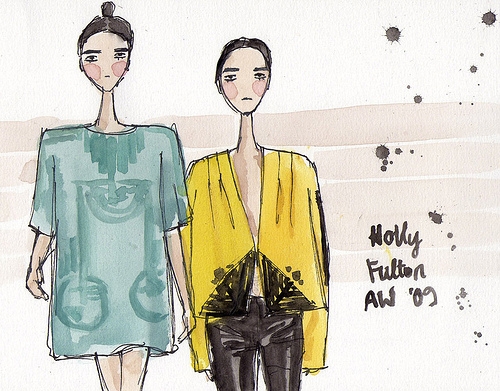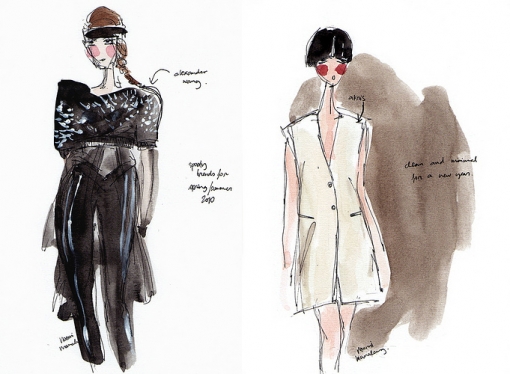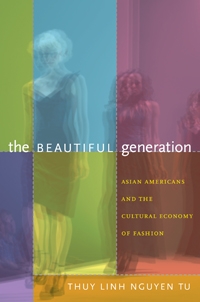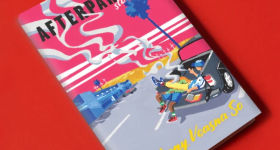Fashion illustrations courtesy of Noemi Manalang [blog|flickr].
Perhaps the most celebrated Fall collections to debut at this year’s Fashion Week were those that creatively incorporated technology. Several designers showcased computer-generated prints, retooling traditional craft textiles into computerized patterns comprising ultra modern garments. But even as fashion critics overwhelmingly celebrated this preponderance of technological innovation, most seemed similarly enamored of Ralph Lauren’s far less pioneering embrace of one of fashion’s oldest tropes: Shanghai Chic. Critics eagerly dedicated valuable column inches to the collection, which featured all the mainstays of Asian-inspired fashion: jade jewelry, golden dragons, cheongsams. While some candidly wondered whether the designer’s invocation of China was a statement about the nation’s growing economic competitiveness, others were simply happy to break out as many tired euphemisms for “Eastern” as possible. (Not only did the “Orient Express” make several stops but East, inevitably, met West.)
The familiar scenario aptly reinforces a key observation made by culture critic Thuy Linh Nguyen Tu in her newly published book, The Beautiful Generation: “Even when freed to dream and invent,” she writes, “[designers] seem only to return to long-held ideas about an exotic and erotic orient.”
The phenomenon Nguyen Tu describes, of Euro-American designers’ quixotic and cyclical infatuation with an often undifferentiated “East,” has for -- literally -- hundreds of years dictated Asia’s participation in one of the largest and oldest industries to date. Asia, in the deft hands of fashion industry titans, is at once a sumptuous fantasy and a convention in need of constant reinterpretation; both an inexpensive manufacturing site and -- as one New York Times critic made a point of mentioning with regard to the Ralph Lauren collection -- an expansive consumer market.
The Beautiful Generation, as much a fashion history as a cultural study, gracefully takes us through the many phases of that evolving dynamic: From Gaultier’s introduction of luxe Chinese coats in seventeenth century Paris, to American Vogue’s strategic establishment of "fashion designer as cultural anthropologist" in the mid-‘90s, and finally to the curiously successfully rise of Asian American designers in the present decade. While it’s all a good read, the last is arguably the highlight of the book; Nguyen Tu’s compelling examination of Asian American designers, whose precarious positions in the industry are plainly defined by their historic exclusion from it, is clearly a point of personal connection for her.

In one way or another, she’s been studying those designers since the 1990s when, as a grad student at New York University, she began noticing that a number of emergent downtown boutiques were helmed by Asian American women. Initially driven by her recognition of a unique cultural phenomenon (up to that point, Asian Americans in the fashion industry had been relegated to low-wage manufacturing jobs), she was eventually propelled by the realization that she shared a lot more with the designers than just a fine fashion sense.
Like many of the designers she interviewed, Nguyen Tu had emigrated from Vietnam as a child, and her family had settled in what she describes as “all-white working class towns in Connecticut … urban spaces where it was hoped we would assimilate faster.” Her working class parents, whose vision of acceptable work centered on the potential for financial security, expected her to become a pharmacist or, if she was really ambitious, a doctor. But her ostensibly poor command of the sciences eventually pushed her towards liberal arts and, to her parent’s dismay, a PhD in American Studies.
“It was like telling them I was going to join the circus,” she said. "And throughout my interviews with the designers I heard the same thing … the same story of how parental expectations enabled us to do the work that we did even as it constrained us.”
As she learned, familial ties and expectations figured prominently in the rise of Asian American designers, informing their careers paths and perspectives on the industry while lending them valuable human and material resources during their lean beginning years. Most of the designers she interviewed (including notables like Philip Lim, Derek Lam and Doo-Ri Chung) were the children of garment producers -- the low wage sewers, cutters and pattern makers upon which the fashion industry relies. From an early age, the designers had assisted their parents with piecework, learning to cut, sew and assemble. Yet few set out to become designers, influenced instead by their parents’ narrow views of acceptable work as much as by cultural stereotypes that depict Asians as industrious but inherently uncreative.
“The majority of people that I interviewed didn’t even go to fashion school,” Nguyen Tu said. “Instead … they went to dental school.”
While many told Nguyen Tu that sewing was in their blood, having been trained in the skill since childhood, most nevertheless pursued radically different careers -- in finance, biology, anthropology, etc. -- before circling back to the fashion industry as designers.
But unlike the prototypical American designer (who, according to Nguyen Tu, strives to distance himself from “unskilled” producers in an effort to elevate his own role in the creative process), Asian American designers have tended toward the reverse. Guided by their intimate connections to garment workers and familial expectations about the nature of acceptable work, they are more inclined to view fashion design as chiefly a business rather than an art, and tend to emphasize their close relationships with producers rather than eschew them. For many, this pays off. While fashion design is an unstable, financially risky, and resource-intense occupation for most, Asian American designers have benefited from their intimacies with producers, who can provide them with both labor and material resources at little or no cost. It’s a crucial advantage that has enabled many Asian Americans to stay competitive in an especially gendered and racialized industry.

And just as the American children of garment workers are increasingly crossing the assembly line -- graduating from the industrial to the creative -- so are Asian sites of outsourcing leveraging their manufacturing industries into more lucrative creative centers. Once the original locales of inexpensive labor, China and Korea have started dedicating considerable resources to cultivating home-grown design talent, sending scores of Chinese and Korean fashion students to New York every year to acquire skills and exposure. Though their fashion industries are fledgling yet, the transformative effort has plainly provoked anxiety within the Euro-American fashion industry; Nguyen Tu notes that the latter has subsequently striven to define itself as a global innovator by reinforcing the industry’s creative vs “unskilled” dichotomy. Euro-American designers are embracing technology, ever-reinventing familiar motifs and further distancing themselves from the mass-producing masses in an effort to maintain their global dominance.
Indeed, the defensive posturing and industry angst to which she alludes were in full swing at this year’s Fashion Week -- in the self-aggrandizing speech of designers, on the ultra-modernized backs of models, and even in laudatory mainstream reviews. Commenting on Ralph Lauren’s collection, for instance, the New York Times’ Suzy Menkes repeatedly juxtaposed descriptions of the designer’s Shanghai-inspired aesthetic with disparaging references to the “fast fashion factories of today’s China” and Asia’s “Made in China”-quality mass productions.
Asian American designers don’t get off too easily either, falling as they do somewhere between artist and producer, American and foreigner. While critics extolled Ralph Lauren’s and Oscar De La Renta’s modernization of “tourist trap” Asian motifs, for example, they also repeatedly and simplistically categorized the commercial success of Asian American designers as the product of Asian consumption. Reviewing Anna Sui’s collection, Menkes patronizingly notes that “Ms. Sui may have had a big success in the Asia of her family origins, but her heart is forever in the England of swinging London, with its layers of history.” At Vogue, Hamish Bowles curiously remarks that Jason Wu’s “conservative” collection would never be as radically deconstructionist as those of the Japanese designer Kawakubo -- notwithstanding the fact that their aesthetics are so radically different that they defy comparison; their only tangible similarity is their (albeit divergent) Asian heritage. Mark Holgale, also writing for Vogue, similarly makes much of Philip Lim’s connections to Asia, attributing the designer’s current and future successes to the voraciously consumptive Chinese -- even as he notes that Chinese consumers are just as “familiar with everyone from Altuzarra to Rodarte.”
The stark differences between critical reception of Asian American work and that of mainstream, establishment designers seems to suggest that, while Asian cultures desperately require Western designers to modernize and retool their elements into something worth purchasing, Asian American designers nevertheless owe everything to their Far Eastern touchstones. In either case, the Euro-American fashion establishment wins … but perhaps not for long.
“I think the dominance of Euro-American fashion will eventually wane,” Nguyen Tu speculated. “They’ve held the monopoly for over 200 years, but I think there will be a radical shift away from the US and Europe as the only centers of fashion, and that China and India and all of these places will rise in a sort of global realignment of where we get our style … and in the production of fashion itself.”
* * *
Welcome to the inaugural post of Hyphen's newest column: Across the Desk, a collaboration of Asian American journalists and scholars. See here for more in the series.
Scholars and journalists interested in contributing to the column, please email erin[at]hyphenmagazine[dot]com.
The Beautiful Generation: Asian Americans and the Cultural Economy of Fashion
By Thuy Linh Nguyen Tu
Duke University Press | 2010











Comments